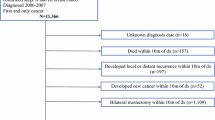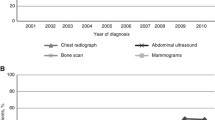Abstract
Background
Although not guideline recommended, studies suggest 50% of locoregional breast cancer patients undergo systemic imaging during follow-up, prompting its inclusion as a Choosing Wisely measure of potential overuse. Most studies rely on administrative data that cannot delineate scan intent (prompted by signs/symptoms vs. asymptomatic surveillance). This is a critical gap as intent is the only way to distinguish overuse from appropriate care.
Objective
Our aim was to assess surveillance systemic imaging post-breast cancer treatment in a national sample accounting for scan intent.
Methods
A stage-stratified random sample of 10 women with stage II–III breast cancer in 2006–2007 was selected from each of 1217 Commission on Cancer-accredited facilities, for a total of 10,838 patients. Registrars abstracted scan type (computed tomography [CT], non-breast magnetic resonance imaging, bone scan, positron emission tomography/CT) and intent (cancer-related vs. not, asymptomatic surveillance vs. not) from medical records for 5 years post-diagnosis. Data were merged with each patient’s corresponding National Cancer Database record, containing sociodemographic and tumor/treatment information.
Results
Of 10,838 women, 30% had one or more, and 12% had two or more, systemic surveillance scans during a 4-year follow-up period. Patients were more likely to receive surveillance imaging in the first follow-up year (lower proportions during subsequent years) and if they had estrogen receptor/progesterone receptor-negative tumors.
Conclusions
Locoregional breast cancer patients undergo asymptomatic systemic imaging during follow-up despite guidelines recommending against it, but at lower rates than previously reported. Providers appear to use factors that confer increased recurrence risk to tailor decisions about systemic surveillance imaging, perhaps reflecting limitations of data on which current guidelines are based.
ClinicalTrials.gov Identifier: NCT02171078.

Similar content being viewed by others
References
Howlander N, Noone AM, Krapcho M, et al. SEER Cancer Statistics Review, 1975–2011. Bethesda, MD: National Cancer Institute; 2014.
Siegel R, DeSantis C, Virgo K, et al. Cancer treatment and survivorship statistics, 2012. CA Cancer J Clin. 2012;62(4):220–41.
Siegel R, Naishadham D, Jemal A. Cancer statistics, 2012. CA Cancer J Clin. 2012;62(1):10–29.
Khatcheressian JL, Hurley P, Bantug E, et al. Breast cancer follow-up and management after primary treatment: American Society of Clinical Oncology clinical practice guideline update. J Clin Oncol. 2013;31(7):961–65.
Khatcheressian JL, Wolff AC, Smith TJ, et al. American Society of Clinical Oncology 2006 update of the breast cancer follow-up and management guidelines in the adjuvant setting. J Clin Oncol. 2006;24(31):5091–97.
NCCN Clinical Practice Guidelines in Oncology Version 2.2011. 2011. http://www.nccn.org/clinical.asp. Accessed 20 Sep 2011.
Grunfeld E, Hodgson DC, Del Giudice ME, et al. Population-based longitudinal study of follow-up care for breast cancer survivors. J Oncol Pract. 2010;6(4):174–81.
Panageas KS, Sima CS, Liberman L, et al. Use of high technology imaging for surveillance of early stage breast cancer. Breast Cancer Res Treat. 2012;131(2):663–70.
Hahn EE, Hays RD, Kahn KL, et al. Use of imaging and biomarker tests for posttreatment care of early-stage breast cancer survivors. Cancer. 2013;119(24):4316–24.
Geurts SM, de Vegt F, Siesling S, et al. Pattern of follow-up care and early relapse detection in breast cancer patients. Breast Cancer Res Treat. 2012;136(3):859-868.
Schnipper LE, Smith TJ, Raghavan D, et al. American Society of Clinical Oncology identifies five key opportunities to improve care and reduce costs: the top five list for oncology. J Clin Oncol. 2012;30(14):1715–24.
American Board of Internal Medicine Foundation. Choosing Wisely Clinician Lists. http://www.choosingwisely.org/clinician-lists. Accessed 11 Apr 2016.
Bilimoria KY, Stewart AK, Winchester DP, et al. The National Cancer Data Base: a powerful initiative to improve cancer care in the United States. Ann Surg Oncol. 2008;15(3):683–90.
Williams RT, Stewart AK, Winchester DP. Monitoring the delivery of cancer care: Commission on Cancer and National Cancer Data Base. Surg Oncol Clin N Am. 2012;21(3):377–88.
Winchester DP, Stewart AK, Bura C, et al. The National Cancer Data Base: A clinical surveillance and quality improvement tool. J Surg Oncol. 2004;85(1):1–3.
Commission on Cancer. Facility Oncology Registry Data Standards. Chicago, IL: Commission on Cancer; 2013.
In H, Bilimoria KY, Stewart AK, et al. Cancer recurrence: an important but missing variable in national cancer registries. Ann Surg Oncol. 2014;21(5):1520–29.
Cossetti RJ, Tyldesley SK, Speers CH, et al. Comparison of breast cancer recurrence and outcome patterns between patients treated from 1986 to 1992 and from 2004 to 2008. J Clin Oncol. 2015;33(1):65–73.
Williams R. Using the margins command to estimate and interpret adjusted predictions and marginal effects. Stata J. 2012;12(2):308–31.
Hahn EE, Tang T, Lee JS, et al. Use of posttreatment imaging and biomarkers in survivors of early-stage breast cancer: inappropriate surveillance or necessary care? Cancer. 2016;122(6):908–16.
21. Colleoni M, Sun Z, Price KN, et al. Annual hazard rates of recurrence for breast cancer during 24 years of follow-up: results from the international breast cancer study group trials I to V. J Clin Oncol. 2016;34(9):927–35.
Institute of Medicine—Committee on Quality of Health Care in America. Crossing the quality chasm: A new health system for the 21st century. Washington, DC: National Academy Press; 2001.
Palli D, Russo A, Saieva C, et al. Intensive vs clinical follow-up after treatment of primary breast cancer: 10-year update of a randomized trial. JAMA. 1999;281(17):1586–86.
Ghezzi P, Magnanini S, Rinaldini M, et al. Impact of follow-up testing on survival and health-related quality-of-life in breast-cancer patients: a multicenter randomized controlled trial. JAMA. 1994;271(20):1587–92.
Delturco MR, Palli D, Cariddi A, et al. Intensive diagnostic follow-up after treatment of primary breast-cancer—a randomized trial. JAMA. 1994;271(20):1593–97.
26. Liberati A. The GIVIO trial on the impact of follow-up care on survival and quality of life in breast cancer patients. Ann Oncol. 1995;6:41–46.
Rojas MP, Telaro E, Russo A, et al. Follow-up strategies for women treated for early breast cancer. Cochrane Database Syst Rev. 2005;(1):CD001768.
Acknowledgment
An abstract based on these findings was selected for a podium presentation at the 2016 Academy Health Annual Research Meeting, Boston, MA, USA, June 2016. The authors wish to thank the cancer registrars and cancer physician liaisons at all participating Commission on Cancer-accredited facilities and National Cancer Database staff for their contributions and dedication to this project. Other members of the Alliance/American College of Surgeons Clinical Research Program (ACS-CRP) Cancer Care Delivery Research PCORI Breast Cancer Surveillance Working Group include Karla Ballman, PhD; Deborah Schrag, MD, MPH; Ann Partridge, MD, MPH; Kathryn Ruddy, MD; Patrick Gavin, RPh; Bettye Green, RN; Jane Perlmutter, PhD, MBA; Elizabeth Berger, MD; Rinaa Punglia, MD, MPH; Ronald Chen, MD, MPH; Nicole Brys, MPH; and Ying Zhang.
Funding
Research reported in this manuscript was funded through a Patient-Centered Outcomes Research Institute (PCORI) award (CE-1304-6543) and the National Cancer Institute at the National Institutes of Health (NIH; Grant number U10CA180821 to the Alliance for Clinical Trials in Oncology). Further funding came from the Building Interdisciplinary Research Careers in Women’s Health Scholar Program and University of Wisconsin Carbone Comprehensive Cancer Center Academic Oncologist Training Program (Neuman; NIH K12 HD055894, 5K12CA087718), and the National Cancer Institute-funded Surgical Oncology Research Training Program (Adesoye; T32CA090217).
Disclaimer
The data used in this study are derived from a de-identified National Cancer Database file. The American College of Surgeons and the Commission on Cancer have not verified and are not responsible for the analytic or statistical methodology employed, or the conclusions drawn from these data by the investigator. Furthermore, the contents of this publication are solely the responsibility of the authors and do not necessarily represent the views of the NIH or the PCORI, its Board of Governors or Methodology Committee.
Disclosure
Jessica R. Schumacher, Heather B. Neuman, George J. Chang, Benjamin D. Kozower, Stephen Edge, Menggang Yu, David J. Vanness, Yajuan Si, Elizabeth A. Jacobs, Amanda B. Francescatti, Patricia Spears, Jeffrey Havlena, Taiwo Adesoye, Daniel McKellar, David Winchester, Elizabeth Burnside, and Caprice C. Greenberg have no conflicts of interest to declare.
Author information
Authors and Affiliations
Consortia
Corresponding author
Additional information
The members of the Alliance ACS-CRP CCDR Breast Cancer Surveillance Working Group are listed in the ‘‘Acknowledgement’’.
Rights and permissions
About this article
Cite this article
Schumacher, J.R., Neuman, H.B., Chang, G.J. et al. A National Study of the Use of Asymptomatic Systemic Imaging for Surveillance Following Breast Cancer Treatment (AFT-01). Ann Surg Oncol 25, 2587–2595 (2018). https://doi.org/10.1245/s10434-018-6496-4
Received:
Published:
Issue Date:
DOI: https://doi.org/10.1245/s10434-018-6496-4




